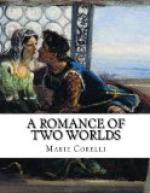“If you go on like this,” she said, “you will be perfectly well in a month.”
I was utterly unable to account for the remedial influence Raffaello Cellini’s presence had upon me; but such as it was I could not but be grateful for the respite it gave me from nervous suffering, and my now daily visits to the artist’s studio were a pleasure and a privilege not to be foregone. Moreover, I was never tired of looking at his pictures. His subjects were all original, and some of them were very weird and fantastic. One large picture particularly attracted me. It was entitled “Lords of our Life and Death.” Surrounded by rolling masses of cloud, some silver-crested, some shot through with red flame, was depicted the World, as a globe half in light, half in shade. Poised above it was a great Angel, upon whose calm and noble face rested a mingled expression of deep sorrow, yearning pity, and infinite regret. Tears seemed to glitter on the drooping lashes of this sweet yet stern Spirit; and in his strong right hand he held a drawn sword—the sword of destruction— pointed forever downwards to the fated globe at his feet. Beneath this Angel and the world he dominated was darkness—utter illimitable darkness. But above him the clouds were torn asunder, and through a transparent veil of light golden mist, a face of surpassing beauty was seen—a face on which youth, health, hope, love, and ecstatic joy all shone with ineffable radiance. It was the personification of Life—not life as we know it, brief and full of care—but Life Immortal and Love Triumphant. Often and often I found myself standing before this masterpiece of Cellini’s genius, gazing at it, not only with admiration, but with a sense of actual comfort. One afternoon, while resting in my favourite low chair opposite the picture, I roused myself from a reverie, and turning to the artist, who was showing some water-colour sketches to Mrs. Everard, I said abruptly:
“Did you imagine that face of the Angel of Life, Signor Cellini, or had you a model to copy from?”




